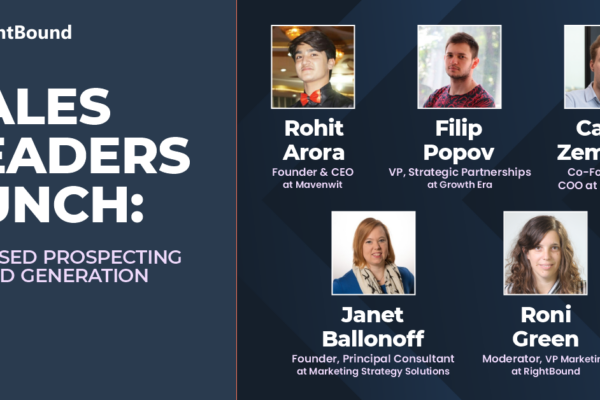
The world of outbound sales is all about capturing prospects’ attention. The competition is fierce, and the people SDRs are trying to engage with (and eventually sell to) are being bombarded by information and their inboxes are flooded with offers.
In today’s attention economy, you’re not going to stand out if your email is generic. The key to getting your emails noticed and acted upon is personalization. Buyers are sophisticated and cookie-cutter solutions aren’t going to work – or even worse – your email is going to be marked as spam.
Put Yourself in Your Prospect’s Shoes
Personalization is all about putting yourself in your prospect’s shoes. Your emails need to tell the prospect what’s in it for them, using their language and showing them that you understand their specific pain points and priorities.
But when you have a large target audience and a meetings booked quota hanging over your head every month, you don’t have time to invest hours of research on each prospect. That’s why many companies with thousands and even tens of thousands of potential prospects send out massive generic email blasts – with less than satisfactory results.
Personalizing emails at scale is about finding the sweet spot between “spray and pray” and individual one-off emails, which are effective but hard to scale.
This is where data can come in very handy.

Five Tactics for Data-Driven Email Personalization at Scale
You’re probably using various data sources in your research and prospecting efforts. The challenge is to assemble that data in one place, intelligently leverage that data to personalize your emails, and then send those emails to the right prospects at the right time.
Here are some proven data-driven tactics for personalizing emails at scale, at both the prospecting stage and for following up with warmer prospects.
1. Identify “triggering events” to improve your prospecting
A “triggering event” is a piece of information that indicates a good prospect/account to target. At the account level, this could be a recent funding round, active hiring for certain roles, a certain department that grew substantially in the last year (more budget), or suppliers/technologies the company is working with.
Examples of triggering events at the prospect (contact) level might be a recent promotion, someone joined the company, or a new role under that person’s responsibility.
Triggering events represent common denominators in accounts/prospects that can then be used to create “buckets” for email personalization (see tip 3 below).
2. Automate your prospecting and contact information sourcing
Make sure to use data sources that provide reliable data on triggering events, and help you find accounts in an efficient manner. After you’ve found an applicable triggering event from a data source (e.g., Sales Navigator), you don’t want to have to collect different prospect details (email, phone number) from different sources manually. Automated prospecting tools can help you incorporate and integrate data into your sales systems, which can then be used to personalize your emails.
3. Crafting personalized email templates
Once you have reliable data within your system, the next step is to write an effective email that leverages that data. The opening sentence or two should get the prospect’s attention with a personalized message showing you did your research.
Be sure to mention the triggering event in your email and tie it to the value proposition of your product or service offering. For example, an email congratulating your prospect on her recent promotion, then mentioning that people in her role often struggle with X, Y, Z and how you’ve helped companies like hers solve that problem.
For each trigger event, create a personalized email template allowing you to send that email to each “bucket” of prospects (i.e., dozens or hundreds of contacts). This tactic allows you to be both personal and scale.
4. Fine tune your target audience using various criteria
The more your message is aligned with what your prospect cares about, the higher the reply rate and the better your chances of further engagement. Different target audiences care about different things, have different priorities, and measure different KPIs.
Personalize your emails using different criteria, such as persona type, seniority level or industry, and adapt your messaging accordingly. For example, if you’re selling a video marketing solution, you may be targeting marketers as well as sales folks. . Each persona type should receive an email focusing on the aspect of your solution that interests them and addresses their specific needs. Similarly, an email to a team lead/manager and an email to a C-level executive should contain different messages. Personalization by industry could be based on dropping names of companies from their industry already using your product (and perhaps adding a link to a case study).
5. Use touchpoints in the prospect’s journey to personalize emails
Personalization at scale goes beyond the initial contact and can be applied throughout the prospect journey to strengthen engagement and book more meetings.
For example, let’s say you sent an email with a survey relevant to what you are offering. You see that the prospect opened the email, clicked on the survey link, started the survey, but never completed it. In other words, you don’t have any information yet from the survey, but you do know there was some interest.
Using the data you have from the outreach flow, create a unique cadence based on that prospect’s behavior and send personalized emails accordingly. In our example, the email would urge them to complete the survey and the next step would be to send a gift card thanking them for their time with a request to set up a short call to discuss areas where your product could help. By automating this process, you can send a follow-up email based on each touchpoint in the outreach flow.

Striking the Right Balance Between Personalization and Scale
By leveraging data from external sources as well as your own sales engagement platform, you can find the elusive balance between personalization and scale. Particularly for small and mid-market companies with large target audiences, data-driven personalization allows you to send highly relevant emails, while still covering a large portion of your TAM (Total Addressable Market).
From the SDR’s perspective, this approach helps your emails stand out from the crowd and creates initial interest with your target audience. Prospects will appreciate that you’ve done your homework before reaching out, which will lead to better email reply rates and ultimately more meetings booked.

How Can RightBound Help You Personalize at Scale?
RightBound automatically personalized the outreach campaigns based on each prospect’s behavior during the engagement flow. By leveraging RightBound’s extensive data sources, the platform automatically chooses and sends a personalized email that best fits the individual prospect based on their behavior and personal characteristics.
Get in touch with our sales dev expert to learn more about it.



